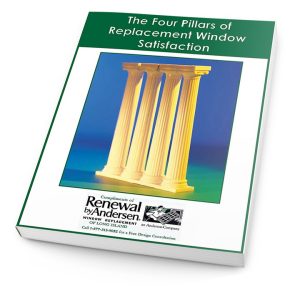MENU


Like cleaning off the air conditioner or opening the pool, your home’s windows are an important element in planning for the arrival of summer on Long Island. If your windows perform well, you’ll enjoy a more comfortable indoor environment without running the air conditioning bill off the chart. Many Long Islanders don’t realize prepping for summer is just as important as getting ready for winter. Here are a few tips to help you create a summer checklist from our professional Renewal by Andersen of replacement window and patio door consultants.
How Do You Start a Summer Weatherization Plan for Windows & Patio Doors?
In many ways, a summer checklist is similar to your winter plan. Checking for air and moisture leaks is vital regardless of the season. If you’re like most people, you don’t want to waste money cooling your indoor air just to have it sneak out because your windows aren’t weather-tight.
If you haven’t upgraded your Long Island home’s windows yet, a summer weatherization plan should start with inspecting your home window units for damage. Renewal by Andersen replacement windows and patio doors are designed to make planning for summer easier.
Different window frame materials respond differently to the environment. For example, replacement windows and patio doors built with Fibrex frames, have a lower thermal expansion rating than most other construction materials, so you won’t see gaps develop between the window and the building envelope like you might with vinyl windows. Other frame materials have other issues. Aluminum frames bend easier than wood or composite frames. Vinyl is light weight, but may pull, twist or warp during extreme temperature variances. Wood is structurally stable, and less likely to develop gaps or sag, but requires extensive maintenance and tends to absorb moisture if you don’t stay on top of chips and cracking paint.
Checking for damage may include spraying water on the outside of each window, being sure to run a stream of water around the edge of the glass and the outside perimeter of your frame on all sides. Check to see if any water gets inside the house or between the window panes if you have multi-pane windows. You can also use the flashlight method after dark. While it won’t detect small cracks, shining a flashlight over all areas where gaps may occur, while someone on the outside watches for rays of light, you’ll be able to see larger cracks.
According to the Department of Energy, it is very important to choose the right weather stripping for the right location – one that will “withstand the friction, weather, temperature changes, and wear and tear associated with its location.”
Over time, daily use, changes in weather and age cause weather stripping to weaken. Weather stripping must also support sash movement – right, left, up and down. Gliding windows tend to develop weather stripping problems earlier than casements because casement windows use compression closure mechanisms that produce less friction than the sliding motion that “drags” across the material every time you open or close your window. Minor issues will turn into major air and moisture leaks if you don’t repair or replace damaged components.
Weather stripping is necessary for movable components, but sealants are appropriate for stationary features. Caulking and other sealants “glue” your glass panes in place, keeping outdoor air and moisture from infiltrating your home. You can find caulk in many forms that include tubes, ropes, and even spray formulas and in many formulations and colors. Be sure to use only caulking designed for exterior use on windows and doors.
If you use harsh chemicals or sharp tools to clean your windows you can damage the sealants. Direct sunlight can also weaken the seals. Detecting leaks involves taking a close look at all areas designed to stay in place. Look for missing sections or globs of sealant that indicate your seal is broken or may have been poorly patched at some point.
When you spray your windows, you may notice leaks around the glass, but it’s also important to look for chips or cracks near the edges. Broken panes should be replaced, whether there is an unsightly hole that obstructs your view, or a tiny crack near the perimeter that allows air and moisture leaking. Keep in mind, even a tiny hole allows the gas-fill to escape, which dramatically reduces the energy-efficiency of an insulated window.
Clean out loose dirt and debris that may damage mechanical rollers and weather stripping and keep your patio doors and sliding windows from operating smoothly. Anything that interferes with smooth operation, whether it is a missing screw designed to stabilize the unit or damaged roller balls, these should be fixed or replaced because these problems often lead to more damage and reduce overall performance.
Once you’ve inspected your windows and patio doors and corrected any problems you find, you’ll want to look at ways to help your windows perform better as the temperature rises. The glass in Renewal by Andersen replacement windows and patio doors have special coatings applied during the manufacturing process that allow you to control light levels and block UV rays that tend to be stronger during summer months.
Even high-quality replacement windows can benefit from additional help during the most extreme temperatures. To help you get the most from the built-in features, you might want to update your window treatments. Curtains and drapes can play an integral role in managing your indoor comfort by blocking direct sunlight and providing an extra layer of insulation. Honeycomb shades, insulated curtains and blinds with reflective backing allow you to express your style while enhancing overall window performance.
Most of us shut our windows tight and turn our AC thermostats down to keep our indoor spaces cooler as the weather heats up. But on those more temperate days or when the temperature is more moderate, opening a couple of windows slightly to encourage ventilation and flush out airborne germs and allergens can’t hurt. Test airflow patterns by opening different windows to see which combination works best for cross ventilation in your home. And, don’t forget to check your window screens. Who wants to open a window and find out too late a swarm of mosquitos or no-see-ums came in with the healthy breeze?
Preparing your home for summer is important if you want to stay comfortable without busting your budget. Whether you’re interested in more tips on conducting your own home inspection, or you found some major issues and are thinking about updating your home with new replacement windows or patio doors, we can help. Just give us a quick all at (866) 609-5033 to and schedule a free home inspection or fill in the short form on this page. Summer is coming – we’ll help you get ready.

Learn Everything You Need to Know BEFORE Buying Replacement Windows